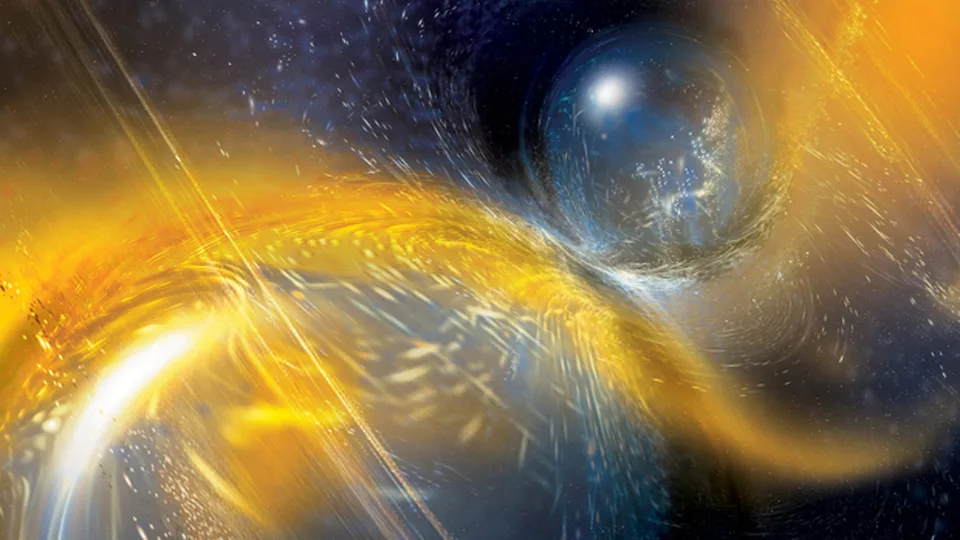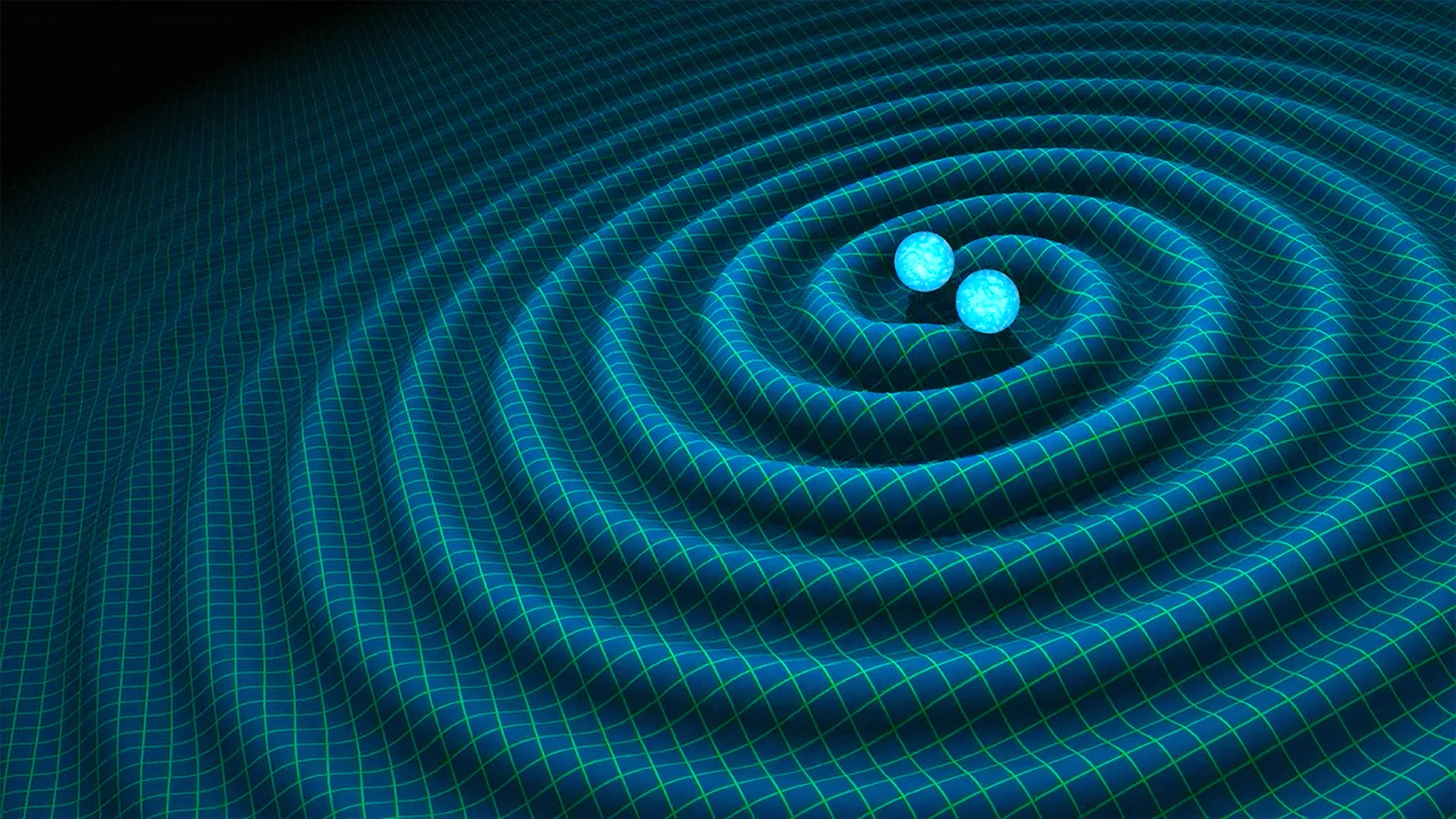
Cosmic ripples point to the birth of a brand new black hole
Gravitational waves swept past Earth last year, revealing a surprisingly massive collision out in the depths of the universe.
The latest detection of gravitational waves has led astronomers to a remarkable discovery.
Far back in time and far out in space - literally, over half a billion years ago and over half a billion light years away from us - two heavyweight neutron stars collided, and likely birthed a brand new black hole in the process.
A neutron star is left over when an immense star, anywhere between 10 and 29 times the mass of the Sun, comes to the end of its lifespan. Betelgeuse, one of the brightest stars in our night sky, is a good example. When the star dies, that is, when it can no longer produce nuclear fusion in its core, its outer layers blow off in an explosion known as a 'supernova'. Meanwhile, its dense core collapses from a size a bit larger than our Sun, down to a sphere just 10 kilometres across.

The famous Crab Nebula is a supernova remnant, with a special type of neutron star - known as a pulsar - at its heart. The supernova that produced the nebula was spotted from Earth by astronomers in the year 1054. Image Credits: NASA, ESA, G. Dubner (IAFE, CONICET-University of Buenos Aires) et al.; A. Loll et al.; T. Temim et al.; F. Seward et al.; VLA/NRAO/AUI/NSF; Chandra/CXC; Spitzer/JPL-Caltech; XMM-Newton/ESA; and Hubble/STScI
The resulting stellar remnant resembles an immense, city-sized atomic nucleus, typically weighing in with a mass just a bit greater than our Sun's - around 1.1-1.4 solar masses. Beyond around 2.1 solar masses, it is thought that the remnant becomes too heavy to keep itself from collapsing further, and it will crush down to form a black hole instead.
When two of these extremely massive objects spiral in towards one another, they warp the fabric of spacetime around them. This produces swirling waves that ripple outwards from the pair, and these waves become stronger, the closer the two objects get to one another. When they finally merge, the waves crest and radiate outwards through the universe, until they finally pass by us here on Earth.

Two neutron stars spiral in towards one another in this artist impression, setting off ripples through spacetime known as gravitational waves. Credit: R. Hurt/Caltech-JPL
The resulting waves are far too small for anyone to actually feel them as they pass, but scientists have constructed very sensitive detectors to pick them up. The first is LIGO, the Laser Interferometer Gravitational-Wave Observatory, which has two stations, one located in Hanford, Washington and the other in Livingston, Louisiana. The other is Virgo, which is located in Italy.
The first binary neutron star collision detected through gravitational waves was during the August 2017 'kilonova' event. This second neutron star merger represented something a bit more special, though. Although no kilonova was detected along with it, the extreme mass of the two objects that produced it flags this discovery as exceptional.
"From conventional observations with light, we already knew of 17 binary neutron star systems in our own galaxy and we have estimated the masses of these stars," Ben Farr, an assistant professor at the University of Oregon and LIGO team member, said in a press release. "What's surprising is that the combined mass of this binary is much higher than what was expected."
According to the scientists, up until now, the upper limit for the combined mass of binary neutron stars was around 2.9 solar masses. Based on measurements, these two neutron stars had a combined bulk that was significantly higher - 3.4 solar masses!
With this neutron star binary colliding, their combined mass most certainly pushed past any limits, causing what was left behind to collapse into a brand new black hole.
RIPPLES THROUGH SPACETIME
Although this merger happened over half a billion years ago, news of the surprising cosmic collision arrived at Earth on April 25, 2019, when the graviational waves produced by the event finally reached us and were picked up by one of the detectors of LIGO.
Usually, astronomers expect to see these ripples picked up by both of LIGO's detectors, and also by Virgo in Italy. Not only do all three detectors provide verification of the event, but they can be used to triangulate its position in the night sky. In this case, however, only LIGO Hanford was operating at the time, and the Virgo detector was apparently just not sensitive enough to pick up these particular ripples.
Even with data from only one detector, astronomers were still able to glean two important pieces of information from it.
The first came from the knowledge that the signal was too weak for Virgo to pick up. This fact told them that the event that spawned these spacetime ripples had to be very far away, since gravitational waves spread out from their source and become smaller as they travel at the speed of light through space. While LIGO has higher resolution and thus can pick up smaller ripples, Virgo's lower resolution puts limits on how far away it can 'see'. Since Virgo did not pick up these particular vibrations, the astronomers could tell that the signal originated from somewhere over 500 million light years away from us.

This artist's illustration shows the space- and mind-bending environment of two neutron stars merging. National Science Foundation/LIGO/Sonoma State University/A. Simonnet
The second thing they could tell from it is exactly how big the objects were that collided and merged. In this case, the answer was surprising. It could have been one of two possibilities - either a collision between a neutron star and an extremly light black hole (lighter than any other known black hole, and probably too light to actually exist), or the merger of two unusually heavyweight neutron stars.
"What we know from the data are the masses, and the individual masses most likely correspond to neutron stars. However, as a binary neutron star system, the total mass is much higher than any of the other known galactic neutron star binaries," Surabhi Sachdev, a member of the LIGO team at Penn State University, said in the press release. "And this could have interesting implications for how the pair originally formed."
Source: LIGO-Caltech
